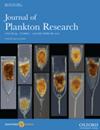Global gradients in species richness of marine plankton functional groups
IF 2
3区 环境科学与生态学
Q2 MARINE & FRESHWATER BIOLOGY
引用次数: 0
Abstract
Abstract The patterns of species diversity of plankton functional groups (PFGs) remain poorly understood although they matter greatly for marine ecosystem functioning. Here, we use an ensemble of empirical species distribution models for 845 plankton species to estimate the global species richness of three phytoplankton and 11 zooplankton functional groups as a function of objectively selected environmental predictors. The annual mean species richness of all PFGs decreases from the low to the high latitudes, but the steepness and the shape of this decrease vary significantly across PFGs. Pteropods, small copepods (Oithonids and Poecilostomatoids) and Salps have the steepest latitudinal gradients, whereas Amphipods and the three phytoplankton groups have the weakest ones. Temperature, irradiance and nutrient concentration are the first-order control on the latitudinal richness patterns, whilst the environmental conditions associated to upwelling systems, boundary currents and oxygen minimum zones modulate the position of the peaks and troughs in richness. The species richness of all PFGs increases with net primary production but decreases with particles size and the efficiency of the biological carbon pump. Our study puts forward emergent biodiversity–ecosystem functioning relationships and hypotheses about their underlying drivers for future field-based and modelling research.海洋浮游生物功能群物种丰富度的全球梯度
浮游生物功能群(PFGs)的物种多样性模式对海洋生态系统的功能有着重要的影响,但对它们的认识却很少。本文利用845种浮游生物的经验物种分布模型,估计了3种浮游植物和11种浮游动物功能群的全球物种丰富度作为客观选择的环境预测因子的函数。各保护区年平均物种丰富度从低纬度到高纬度呈下降趋势,但下降的幅度和形状在不同保护区之间存在显著差异。翼足类、小桡足类(Oithonids和Poecilostomatoids)和海带类的纬度梯度最大,而片足类和三个浮游植物类群的纬度梯度最弱。温度、辐照度和养分浓度是纬度丰富度格局的一级控制因素,而与上升流系统、边界流和最低氧带相关的环境条件调节了丰富度波谷的位置。所有PFGs的物种丰富度随净初级生产量的增加而增加,但随粒径和生物碳泵效率的提高而降低。我们的研究提出了新兴生物多样性与生态系统功能之间的关系,并对其潜在驱动因素进行了假设,为未来的实地研究和建模研究提供了基础。
本文章由计算机程序翻译,如有差异,请以英文原文为准。
求助全文
约1分钟内获得全文
求助全文
来源期刊

Journal of Plankton Research
生物-海洋学
CiteScore
3.50
自引率
9.50%
发文量
65
审稿时长
1 months
期刊介绍:
Journal of Plankton Research publishes innovative papers that significantly advance the field of plankton research, and in particular, our understanding of plankton dynamics.
 求助内容:
求助内容: 应助结果提醒方式:
应助结果提醒方式:


